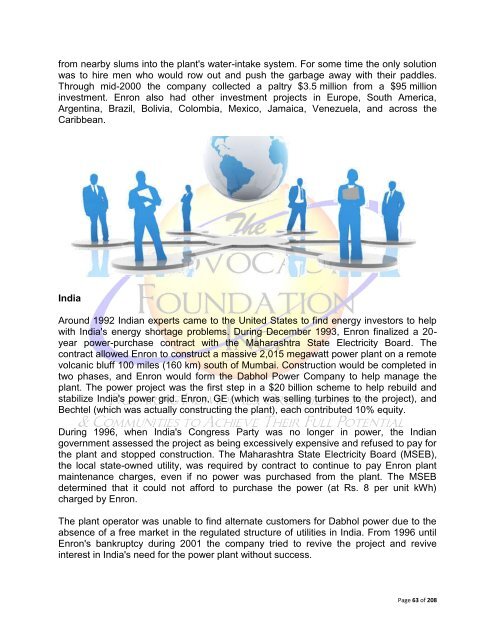The Sarbanes-Oxley Act of 2002
The Sarbanes-Oxley Act of 2002
The Sarbanes-Oxley Act of 2002
Create successful ePaper yourself
Turn your PDF publications into a flip-book with our unique Google optimized e-Paper software.
from nearby slums into the plant's water-intake system. For some time the only solution<br />
was to hire men who would row out and push the garbage away with their paddles.<br />
Through mid-2000 the company collected a paltry $3.5 million from a $95 million<br />
investment. Enron also had other investment projects in Europe, South America,<br />
Argentina, Brazil, Bolivia, Colombia, Mexico, Jamaica, Venezuela, and across the<br />
Caribbean.<br />
India<br />
Around 1992 Indian experts came to the United States to find energy investors to help<br />
with India's energy shortage problems. During December 1993, Enron finalized a 20-<br />
year power-purchase contract with the Maharashtra State Electricity Board. <strong>The</strong><br />
contract allowed Enron to construct a massive 2,015 megawatt power plant on a remote<br />
volcanic bluff 100 miles (160 km) south <strong>of</strong> Mumbai. Construction would be completed in<br />
two phases, and Enron would form the Dabhol Power Company to help manage the<br />
plant. <strong>The</strong> power project was the first step in a $20 billion scheme to help rebuild and<br />
stabilize India's power grid. Enron, GE (which was selling turbines to the project), and<br />
Bechtel (which was actually constructing the plant), each contributed 10% equity.<br />
During 1996, when India's Congress Party was no longer in power, the Indian<br />
government assessed the project as being excessively expensive and refused to pay for<br />
the plant and stopped construction. <strong>The</strong> Maharashtra State Electricity Board (MSEB),<br />
the local state-owned utility, was required by contract to continue to pay Enron plant<br />
maintenance charges, even if no power was purchased from the plant. <strong>The</strong> MSEB<br />
determined that it could not afford to purchase the power (at Rs. 8 per unit kWh)<br />
charged by Enron.<br />
<strong>The</strong> plant operator was unable to find alternate customers for Dabhol power due to the<br />
absence <strong>of</strong> a free market in the regulated structure <strong>of</strong> utilities in India. From 1996 until<br />
Enron's bankruptcy during 2001 the company tried to revive the project and revive<br />
interest in India's need for the power plant without success.<br />
Page 63 <strong>of</strong> 208

















